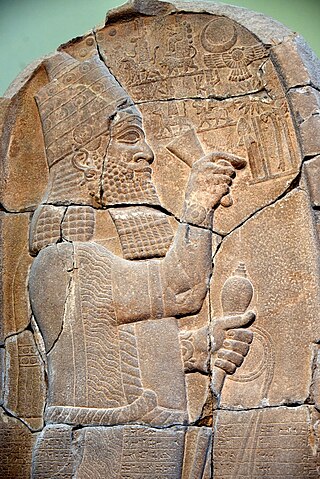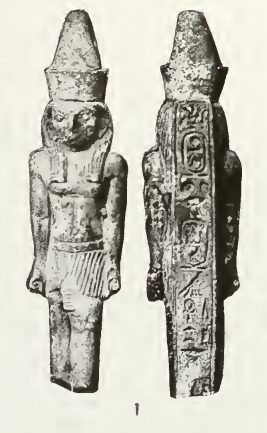Related Research Articles

The 7th century BC began the first day of 700 BC and ended the last day of 601 BC.
This article concerns the period 679 BC – 670 BC.
The year 664 BC was a year of the pre-Julian Roman calendar. In the Roman Empire, it was known as year 90 Ab urbe condita. The denomination 664 BC for this year has been used since the early medieval period, when the Anno Domini calendar era became the prevalent method in Europe for naming years.
The year 668 BC was a year of the pre-Julian Roman calendar. In the Roman Empire, it was known as year 86 Ab urbe condita. The denomination 668 BC for this year has been used since the early medieval period, when the Anno Domini calendar era became the prevalent method in Europe for naming years.
The year 669 BC was a year of the pre-Julian Roman calendar. In the Roman Empire, it was known as year 85 Ab urbe condita. The denomination 669 BC for this year has been used since the early medieval period, when the Anno Domini calendar era became the prevalent method in Europe for naming years.

Taharqa, also spelled Taharka or Taharqo, was a pharaoh of the Twenty-fifth Dynasty of Egypt and qore (king) of the Kingdom of Kush, from 690 to 664 BC. He was one of the "Black Pharaohs" who ruled over Egypt for nearly a century.

Esarhaddon, also spelled Essarhaddon, Assarhaddon and Ashurhaddon was the king of the Neo-Assyrian Empire from the death of his father Sennacherib in 681 BC to his own death in 669. The third king of the Sargonid dynasty, Esarhaddon is most famous for his conquest of Egypt in 671 BC, which made his empire the largest the world had ever seen, and for his reconstruction of Babylon, which had been destroyed by his father.

Ashurbanipal was the king of the Neo-Assyrian Empire from 669 BC to his death in 631. He is generally remembered as the last great king of Assyria. Ashurbanipal inherited the throne as the favored heir of his father Esarhaddon; his 38-year reign was among the longest of any Assyrian king. Though sometimes regarded as the apogee of ancient Assyria, his reign also marked the last time Assyrian armies waged war throughout the ancient Near East and the beginning of the end of Assyrian dominion over the region.

Wahibre Psamtik I was the first pharaoh of the Twenty-sixth Dynasty of Egypt, the Saite period, ruling from the city of Sais in the Nile delta between 664–610 BC. He was installed by Ashurbanipal of the Neo-Assyrian Empire, against the Kushite rulers of the Twenty-fifth Dynasty, but later gained more autonomy as the Assyrian Empire declined.

Menkheperre Necho I was a ruler of the ancient Egyptian city of Sais. He was the first securely attested local Saite king of the 26th Dynasty of Egypt who reigned for 8 years (672–664 BCE) according to Manetho's Aegyptiaca. Egypt was reunified by his son Psamtik I.
Tantamani, also known as Tanutamun or Tanwetamani was ruler of the Kingdom of Kush located in Northern Sudan, and the last pharaoh of the Twenty-fifth Dynasty of Egypt. His prenomen or royal name was Bakare, which means "Glorious is the Soul of Re."

The Third Intermediate Period of ancient Egypt began with the death of Pharaoh Ramesses XI in 1077 BC, which ended the New Kingdom, and was eventually followed by the Late Period. Various points are offered as the beginning for the latter era, though it is most often regarded as dating from the foundation of the Twenty-Sixth Dynasty by Psamtik I in 664 BC, following the departure of the Nubian Kushite rulers of the Twenty-fifth Dynasty after they were driven out by the Assyrians under King Ashurbanipal. The use of the term "Third Intermediate Period", based on the analogy of the well-known First and Second Intermediate Periods, was popular by 1978, when British Egyptologist Kenneth Kitchen used the term for the title of his book on the period. While Kitchen argued that the period was 'far from being chaotic' and hoped that his work would lead to the abolishment of the term, with his own preference being the 'Post-Imperial epoch', his use of the term as a title seems only to have entrenched the use of the term.

The Kingdom of Kush, also known as the Kushite Empire, or simply Kush, was an ancient kingdom in Nubia, centered along the Nile Valley in what is now northern Sudan and southern Egypt.

The Twenty-fifth Dynasty of Egypt, also known as the Nubian Dynasty, the Kushite Empire, the Black Pharaohs, or the Napatans, after their capital Napata, was the last dynasty of the Third Intermediate Period of Egypt that occurred after the Nubian invasion.

The Sargonid dynasty was the final ruling dynasty of Assyria, ruling as kings of Assyria during the Neo-Assyrian Empire for just over a century from the ascent of Sargon II in 722 BC to the fall of Assyria in 609 BC. Although Assyria would ultimately fall during their rule, the Sargonid dynasty ruled the country during the apex of its power and Sargon II's three immediate successors Sennacherib, Esarhaddon and Ashurbanipal are generally regarded as three of the greatest Assyrian monarchs. Though the dynasty encompasses seven Assyrian kings, two vassal kings in Babylonia and numerous princes and princesses, the term Sargonids is sometimes used solely for Sennacherib, Esarhaddon and Ashurbanipal.

The sack of Thebes took place in 663 BC in the city of Thebes at the hands of the Neo-Assyrian Empire under king Ashurbanipal, then at war with the Kushite Twenty-fifth Dynasty of Egypt under Tantamani, during the Assyrian conquest of Egypt. After a long struggle for the control of the Levant which had started in 705 BC, the Kushites had gradually lost control of Lower Egypt and, by 665 BC, their territory was reduced to Upper Egypt and Nubia. Helped by the unreliable vassals of the Assyrians in the Nile Delta region, Tantamani briefly regained Memphis in 663 BC, killing Necho I of Sais in the process.

The Rassam cylinder is a cuneiform cylinder, forming a prism with ten faces, written by Neo-Assyrian king Ashurbanipal in the 7th century BCE, in 643 BCE. The cylinder was discovered in the North Palace of Nineveh by Hormuzd Rassam in 1854, hence its name. It is located in the British Museum.

The Assyrian conquest of Egypt covered a relatively short period of the Neo-Assyrian Empire from 673 to 663 BCE. The conquest of Egypt not only placed a land of great cultural prestige under Assyrian rule but also brought the Neo-Assyrian Empire to its greatest extent.
References
- ↑ "What Were the Largest Cities Throughout History?". Archived from the original on 2016-08-18. Retrieved 2006-03-01.
- ↑ Paschal O'Hare (2019). "Multiradionuclide evidence for an extreme solar proton event around 2,610 B.P. (~660 BC)". Proceedings of the National Academy of Sciences. 116 (13): 5961–5966. Bibcode:2019PNAS..116.5961O. doi: 10.1073/pnas.1815725116 . PMC 6442557 . PMID 30858311.